
In the 17th & 18th centuries as the roads to Norwich improved coach travel brought an increasing number of visitors
to Norwich creating a demand for goods and services. At the same time the topography of the market changed as buildings
were erected across the market place.The market area in this period was squalid and dirty with rotting food and horse
manure trapped in the cobble stones. It was also badly lit. The pipes for the new “Gasolier”, erected in the centre of
the market place, were laid in 1820 by the Norwich Gas Company. It was the first gas lamp in the city and stood for sixty
years. During the second half of the 19th century much new building took place: the Guildhall acquired Victorian embellishments,
the Angel Inn was transformed into the Royal Hotel before emerging as the Royal Arcade whilst the old Fishmarket was
replaced somewhat bizarrely by a grand neo-classical building!
- The Walk
- Market Place
- Coaching Inns
- Revolution
- Shops
- Buildings
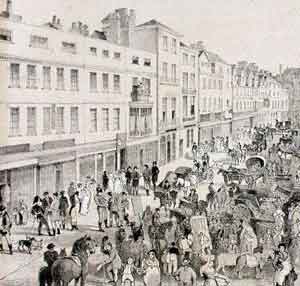 By the second half of the 17th century old barriers to retail selling were coming down and superior shops
geared to gentry tastes were opening. "Nether Row" i.e. the lowest street of the Market, became
a favourite promenade for the gentry and earned the name which it still holds today "Gentleman's Walk". "The
Walk" had high quality shops selling luxury goods – hats, gloves, leather goods, tea and coffee. It
was an hospitality centre with at least 4 large coaching inns facing the Market Place. Only The Lamb now
remains.
By the second half of the 17th century old barriers to retail selling were coming down and superior shops
geared to gentry tastes were opening. "Nether Row" i.e. the lowest street of the Market, became
a favourite promenade for the gentry and earned the name which it still holds today "Gentleman's Walk". "The
Walk" had high quality shops selling luxury goods – hats, gloves, leather goods, tea and coffee. It
was an hospitality centre with at least 4 large coaching inns facing the Market Place. Only The Lamb now
remains.
The Rev Joshua Larwood, a country rector, described Gentleman’s Walk:-“……thronged with a collection of very interesting character – the merchant, the manufacturer, the magistrate, the provincial yeoman, the military officer, the affluent landlord and thriving tenant, the recruiting officer, the clergy, faculty, barristers and all the various characters of polished and professional society.
Whilst the young Horatio Nelson and his brother William were at school in Norwich, they were visited by their great-uncle John, who took them out for a day in the city. They had coffee at Saunders Coffee House on Gentleman’s Walk and visited the Guildhall. Later they went round the market place, where they listened to the traders, crying out that they were now selling their wares at cheaper prices. This was followed by a fine dinner at the White Swan, near St Peter Mancroft church.
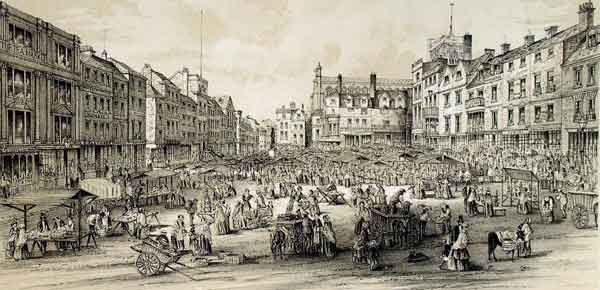
By 1800 the lay out of the medieval market place had altered as buildings encroached the area. Three & four storey buildings stretched across the market place north to south and another row of tall houses running east to west were located up the hill in front of St Peter Mancroft Church. In the 1850 print (left) the houses can clearly be seen.The meat & fish market were hidden behind the buildings on the right. The Walk is on the left.
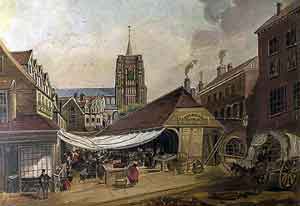 Thus the area had become fragmented. The Great Market was separated from the "Upper Market" which housed the meat & fish
stalls. Wheeled vehicles had access to the latter via Guildhall Hill otherwise they were linked by two small passages, one
of which survives today as Pudding Lane. One result of this action was that the shambles and the Fish Market , pictured below,
were hidden from the gentry during their perambulations along the walk - one cannot be so sure that the smell was similarly
disguised (Both pictures reproduced by permission of Norwich Museum & Art Gallery).
Thus the area had become fragmented. The Great Market was separated from the "Upper Market" which housed the meat & fish
stalls. Wheeled vehicles had access to the latter via Guildhall Hill otherwise they were linked by two small passages, one
of which survives today as Pudding Lane. One result of this action was that the shambles and the Fish Market , pictured below,
were hidden from the gentry during their perambulations along the walk - one cannot be so sure that the smell was similarly
disguised (Both pictures reproduced by permission of Norwich Museum & Art Gallery).
Viewing the market place, one gentleman remarked that the women were “ranged in equidistant
rows, with a regularity little short of military precision”. The market stalls used to be parallel with the
Walk, not as now, up and down.
As the 17th century progresses the congestion caused by livestock intensified and in 1738, the weekly livestock sales were transferred to a site on the eastern side of the Castle mound - where they were still held until the 1960s.
Other smaller changes occurred as trading evolved. Thus by the 1800s the area near the tower of St Peter Mancroft was being used for a lumber or wood market and the stalls near the churchyard had been taken over by linen drapers.
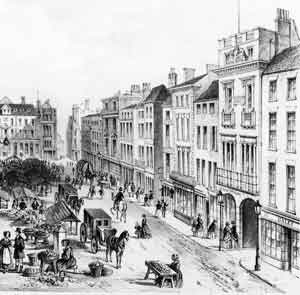 As
coaching traffic increased, the inns around the market place grew in importance as they became pivotal to
the commercial and social life of the city. Their role was far reaching. Not only did they serve as hostelries
and long distance coach stations, but they but also provided business premises, salerooms and entertainment
venues.
As
coaching traffic increased, the inns around the market place grew in importance as they became pivotal to
the commercial and social life of the city. Their role was far reaching. Not only did they serve as hostelries
and long distance coach stations, but they but also provided business premises, salerooms and entertainment
venues.
At least four large inns opened onto the Walk. They were all similar in construction. Narrow gateways opened onto long yards which were overlooked by guest rooms on the first and second floors.Public rooms were grouped around the ground floor which included warehouses used by itinerant dealers for the storage and sale of their stock. The most famous of the Inns along the Walk was the Angel ,later renamed The Royal. On the right we see the entrance to the Inn which by the end of the 19th century had been converted into the Royal Arcade. The Kings Head (later relocated) was also popular. Further down leading onto the Haymarket was the Star Inn, whilst in the shadow of St Peter Mancroft was found the White Swan
We complain about traffic jams today but one can only imagine the mayhem that occurred at the peak of the coaching era. After manoeuvring their team of horses out of a narrow yard the coachmen had to avoid the obstacles thrown up by the market before following narrow roads out of the city - quite an adventure. Railways reached the city in 1842 and although they only replaced coach travel gradually they marked the beginning of the end for the coaching inns.
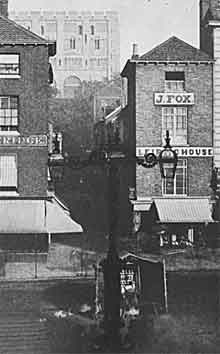
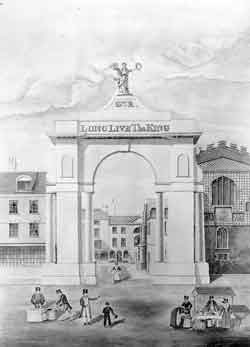
Throughout the 18th and 19th centuries the market place was the venue for large political meetings, and the site of polling booths for city and county elections. It was the centre for public celebrations, bonfires, parades and civic pageantry, including the building of celebratory arches and painted transparencies, lit behind by candles, placed in windows – sometimes causing the inevitable localised fire.
When war between Britain and France broke out at the time of the French Revolution, the price of wheat (and bread) was at an all time high. After yet another price rise, a number of exasperated townsfolk followed Mr Bloom, the Trowse miller, shrieking and complaining, to the market place. He took refuge in the Guildhall, whereupon the crowd tried to break down the door. The militia was sent for and Bloom was escorted to safety, through a shower of sticks, stones and potatoes. Norwich was considered a “Jacobin City”, and it was thought that if Revolution crossed the channel, it would begin here in Norwich.
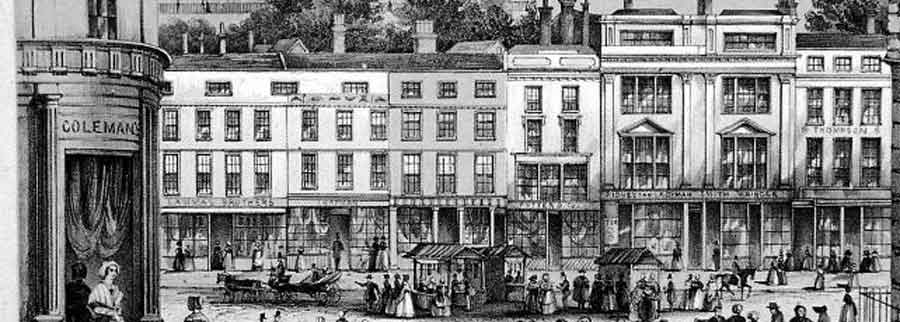 In the Georgian era these were some of the shops that were located from the corner of London Street (then Cockey Lane) along Gentlemans's Walk :
In the Georgian era these were some of the shops that were located from the corner of London Street (then Cockey Lane) along Gentlemans's Walk :
- Benjamin Boardman’s hat shop
- John Oxley, rival hat shop a few doors down, where Nancy Woodforde spent 23s on a black beaver hat with a purple cockade and band.
- J Clarke, a haberdasher, who served funerals, dyed hats and umbrellas
- J Challis had a shoe shop and in 1791 was able to reduce his prices due to a fall in the price of Spanish leather – best bespoke pumps at 5. 6d, “inferior” pumps at 4s 6d, and ladies’ string clogs at 2s 3d a pair.
- At No 4 was P J Knights’ warehouse with the finest Norwich shawls, woven from fine wool and silk (4 yards square without a seam). These shawls were later to be provided to the Queen and Princesses. (ref. collection in the Castle Museum)
- Dunhams & Yallop – Goldsmiths
- John Cozens had a grocery store (turnover of £400 a week by 1801)
- John Toll & Co. – linen and drapery. Elizabeth Gurney (later Fry) and her sisters watched the 1796 elections from his shop.
- Next door, Thomas Bignold sold brandy, wine and hops, but went on to find fame as the founder of Norwich Union (originally the Norfolk & Norwich General Assurance Co)
- Gardiners’ Print Shop – “a perfect likeness in miniature profile for 2s 6d” and lessons for ladies in painting.
- James Critchfield – cutlery shop.
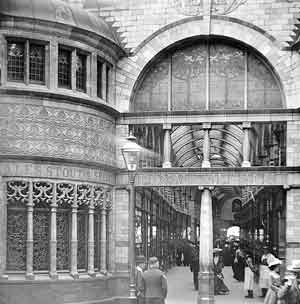 Today the character of the market place owes much to the buildings which surround it. The Guildhall & St Peter Mancroft Church were built in the fifteenth century - although the Victorians couldn't resist making the odd "improvement". Others were built/ significantly altered in the 19th century :
Today the character of the market place owes much to the buildings which surround it. The Guildhall & St Peter Mancroft Church were built in the fifteenth century - although the Victorians couldn't resist making the odd "improvement". Others were built/ significantly altered in the 19th century :
The Royal Arcade was opened in 1899. Its architect was George Skipper and it is built in Art Nouveau style. Glazed Doulton tiles depict peacocks and the floor came from Italy and was laid by Italian craftsmen. The lights are not contemporary with the building and were provided in the restoration in the 1980s. A local newspaper said:-“it’s as if a fragment of the Arabian Nights had been dropped into the heart of the old City”. Pevsner said it was “innocent from the front, but very naughty once its back is turned”. Langley’s Toy Shop is the only original business remaining in the Royal Arcade. The Arcade was built over the site of the Royal Hotel, an Elizabethan inn originally called The Angel although the name was changed in honour of Queen Victoria on her marriage.
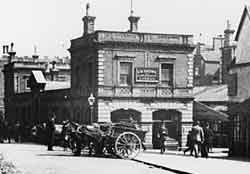 The Sir Garnet Wolseley started trading c1861 although some parts of the building are much older as it took over the premises of an older establishment "The Baron of Beef" The building with its distinctive rounded balconies is instantly recognisable today & is one of the few market pubs still trading
The Sir Garnet Wolseley started trading c1861 although some parts of the building are much older as it took over the premises of an older establishment "The Baron of Beef" The building with its distinctive rounded balconies is instantly recognisable today & is one of the few market pubs still trading
 Jarrolds was established on their site in 1840, primarily to sell the books they printed and published. The
current building was built by George Skipper and dates from 1902. Originally there was a dome on the corner
roof, but this idea was abandoned due to financial constraints.
Jarrolds was established on their site in 1840, primarily to sell the books they printed and published. The
current building was built by George Skipper and dates from 1902. Originally there was a dome on the corner
roof, but this idea was abandoned due to financial constraints.
In 1860 the Fish Market which had stood by the Guildhall for over 600 years was replaced by a grand neoclassical
building (pictured)designed by the County Surveyor Mr E Benst.The project was beset by problems – a worker was killed and
the surveyor accused of taking bribes and forced to resign. By 1914 it had been taken over as office space by the ever
expanding council before being demolished in 1938 to make way for the new City Hall.
It was not until the 20th century that the City Hall would be built, at the same time the market place underwent a radical overhaul.
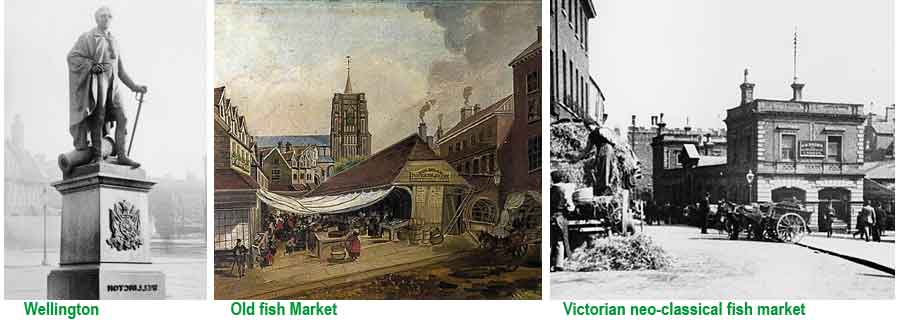
The old fish market, which had stood near the Guildhall for over 700 years was finally demolished and a neo-classical building designed by the County Surveyor built in its place (c. 1860).
In 1886, a market fishmonger called Arthur Riches murdered his wife in Gentleman’s Walk. She had left him two weeks earlier but when he saw her wearing earrings he thought another man was involved and stabbed her in the neck. He was tried, found guilty and sentenced to death but the sentence was commuted to life imprisonment as he was “sorely provoked”. Even his father-in-law had warned him to have nothing to do with his daughter!